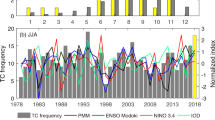Summary
The 2006–2007 Southern Indian Ocean tropical cyclone season proved to be devastating for the already flood-ravaged coastline of Mozambique. The landfall of Tropical Cyclone Favio on 22 February 2007 led to several deaths and considerable damage. A unique aspect of Tropical Cyclone Favio was its westward track around the southern tip of Madagascar and then northwestwards through the Mozambique Channel to make landfall in southern Mozambique – most tropical cyclones in this region track southeastwards after approaching Madagascar and recurve back into the South Indian Ocean. In addition to its track, Tropical Cyclone Favio was highly unusual in that it made landfall in Mozambique during an El Niño year, an occurrence that has only happened one other time in the known record. It is shown that the impacts of the 2006–2007 El Niño over the South Indian Ocean (in terms of sea surface temperature and atmospheric circulation) were very different from previous El Niño events, thus helping to create more favourable conditions for landfall than would otherwise be expected. An analysis relating the unusual behaviour of Favio to the large scale climate mode patterns in 2006–2007 is presented. It is concluded that the unique track and anomalous landfall of Tropical Cyclone Favio are related and that seasonally-based statistical models for predicting the risk of landfall in Mozambique should be adjusted to accommodate anomalous circulation patterns that occur on synoptic to intraseasonal scales.
Similar content being viewed by others
References
JC Hermes CJC Reason (2005) ArticleTitleOcean model diagnosis of interannual co-evolving SST variability in the South Indian and Atlantic Oceans J Climate 18 2864–2882 Occurrence Handle10.1175/JCLI3422.1
JC Hermes CJC Reason (2008) ArticleTitleAnnual cycle of the South Indian Ocean (Seychelles-Chagos) thermocline ridge in a regional ocean model J Geophys Res 113 C04035 Occurrence Handle10.1029/2007JC004363
MR Jury B Pathack B Parker (1999) ArticleTitleClimatic Determinants and statistical prediction of tropical cyclone days in the Southwest Indian Ocean J Climate 12 1738–1746 Occurrence Handle10.1175/1520-0442(1999)012<1738:CDASPO>2.0.CO;2
E Kalnay M Kanamitsu R Kistler W Collins D Deaven L Gandin M Iredell S Saha G White J Woollen Y Zhu A Leetmaa B Reynolds M Chelliah W Ebisuzaki W Higgins J Janowiak K Mo C Ropelewski J Wang R Jenne D Joseph (1996) ArticleTitleThe NCEP/NCAR 40-year reanalysis project Bull Amer Meteor Soc 77 437–471 Occurrence Handle10.1175/1520-0477(1996)077<0437:TNYRP>2.0.CO;2
C Kummerow CW Barnes T Kozu J Shiue J Simpson (1998) ArticleTitleThe Tropical Rainfall Measuring Mission (TRMM) sensor package J Atmos Oceanic Technol 15 809–817 Occurrence Handle10.1175/1520-0426(1998)015<0809:TTRMMT>2.0.CO;2
Lucio F, Muianga A, Muller M (2007) Flood Management in Mozambique climate risk management in Africa: learning from practice. In: Hellmuth ME, Moorhead A, Thomson MC, Williams J (eds) International Research Institute for Climate and Society
Padgett G (2007). Monthly Global Tropical Cyclone Summary: February 2007. http://www.maybagyo.com/garyp_mgtcs/feb07sum.htm. Accessed May 23, 2007
CJC Reason (2007) ArticleTitleTropical cyclone Dera, the unusual 2000/01 tropical cyclone season in the Southwest Indian Ocean and associated rainfall anomalies in southern Africa. Special Issue on Tropical Cyclones Meteorol Atmos Phys 97 IssueID1–4 273–290
CJC Reason RJ Allan JA Lindesay TJ Ansell (2000) ArticleTitleENSO and climatic signals across the Indian Ocean basin in the global context: Part I: Interannual composite patterns Int J Climatol 20 1285–1327 Occurrence Handle10.1002/1097-0088(200009)20:11<1285::AID-JOC536>3.0.CO;2-R
CJC Reason A Keibel (2004) ArticleTitleTropical cyclone Eline and its unusual penetration and impacts over the Southern African Mainland Wea Forecast 19 789–805 Occurrence Handle10.1175/1520-0434(2004)019<0789:TCEAIU>2.0.CO;2
F Vitart DLT Anderson T Stockdale (2003) ArticleTitleSeasonal forecasting of tropical cyclone landfall over Mozambique J Climate 16 3932–3945 Occurrence Handle10.1175/1520-0442(2003)016<3932:SFOTCL>2.0.CO;2
World Meteorological Organization (2007) Meeting of Severe Weather Forecasting Demonstration Project – Final Report
S-P Xie H Annamalai FA Schott JP McCreary (2002) ArticleTitleStructure and mechanisms of south Indian Ocean climate variability J Climate 15 864–878 Occurrence Handle10.1175/1520-0442(2002)015<0864:SAMOSI>2.0.CO;2
Author information
Authors and Affiliations
Corresponding author
Additional information
Correspondence: Chris J. C. Reason, Department of Oceanography, University of Cape Town, Private Bag X3, Rondebosch 7701, South Africa
Rights and permissions
About this article
Cite this article
Klinman, M., Reason, C. On the peculiar storm track of TC Favio during the 2006–2007 Southwest Indian Ocean tropical cyclone season and relationships to ENSO. Meteorol Atmos Phys 100, 233–242 (2008). https://doi.org/10.1007/s00703-008-0306-7
Received:
Accepted:
Published:
Issue Date:
DOI: https://doi.org/10.1007/s00703-008-0306-7




